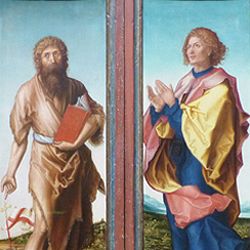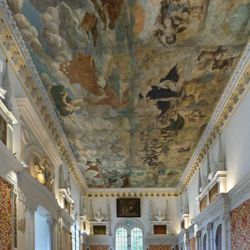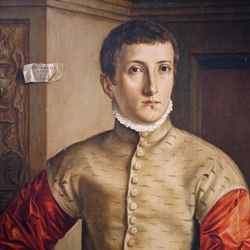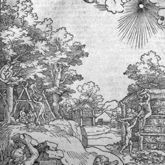Georg
Pencz
painter, draftsman, copperplate engraver, woodcut contourist
born Windsheim ?, um 1502
died Breslau, Oct 1550
Painter, copperplate engraver and draftsman, strongly influenced by Italian painting, can be considered to be a successor of Durer´s. Highly appreciated as a portraitist by the Nuremberg Council.
_________________________________
* c. 1500/02 possibly Windsheim, where relatives of him still lived in 1555 - † Oct. 1550 Leipzig or Breslau. ∞ Nuremberg presumably 18.5.1529 Margaretha, daughter of Michael Graff, painter; 13 children.
On 8.8.1523 he acquired the citizenship and paid 4 fl. Possibly he was already busy in 1521 with other painters with the repainting of the town hall hall after Albrecht Dürer's designs, but this is only handed down by later sources. On 26.2.1525 he was expelled from the city for atheistic and anarchistic statements as a "godless painter" together with the brothers Sebald and Barthel Beham, a stay in Windsheim was granted to him shortly after. At the intercession of Melchior Pfinzing, the painters received permission to return with the Rv. of 16.11.1525. From the period from 1526 to 1529 and from the beginning of the 40s no documents concerning the artist seem to have survived, so that for these periods it is assumed that Pencz was repeatedly in Italy. This is not only suggested by the stylistic findings of his works, but also reported by early artist biographers such as J. von Sandrart and J. G. Doppelmayr. Influences from Venetian (Giorgione, Palma) and Florentine painting (Bronzino, Giulio Romano) in particular can be clearly seen in his oeuvre. Especially in his ceiling painting "Fall of Phaeton", which he painted in 1534 for the Hirschvogelsaal, the knowledge of the works of Giulio Romano for the Palazzo del Tè can be assumed. With a letter of 31.5.1532 Pencz placed himself in the service of the councillors against an annual maintenance fee of 10 fl. This was increased to 24 fl. in 1539. In 1533/36 he worked with other painters on the genealogical book created by Conrad Haller, which the council later purchased. Together with Sebald Beck he made a city model with the fortifications, for which the council paid him 120 fl. on 16.9.1542. In 1548 Pencz made a "Hieronymus" for the council, for which he received 80 fl. In addition to works for the council and Nuremberg citizens, he also executed works for external clients. In 1535 he painted the wing paintings for the so-called silver altar on the Wawel in Krakow. In 1543, a son of Pencz presented the Nuremberg Council with a portrait of Antoine Perrenot de Granvelle, Bishop of Arras, for which he received a tip. Despite the good order situation, he had to sell his household goods, clothing and other movable property to his parents-in-law on 7.3.1542, apparently due to a lack of money. With a document dated 12.9.1550 he was appointed court painter to Duke Albrecht of Prussia. On the way to Königsberg he probably died in Leipzig or Breslau (contradictory information in a Rv. and in the death books). Pencz was considered one of the most outstanding painters of the Dürer succession, who was especially appreciated as a portraitist by the Nuremberg council. He also made significant contributions as a graphic artist; his copperplate engravings, signed and dated GP, were produced between 1535 and 1547. In addition to biblical themes from the Old and New Testaments, he took up motifs from ancient mythology and allegory. It is disputed whether the somewhat earlier prints signed IB (ca. 1514 to 1530), which are more strongly influenced by Dürer's work, can be attributed to Pencz. Also, the attribution of some woodcuts is not clear, especially the sequence of the seven planets, which is attributed to Pencz and Sebald Beham. Pencz is also named as the designer of several single-leaf woodcuts from the 1540s, as well as the book illustrations of Rivius' architecture. Panzer recorded his self-portrait. Penz Street in Nuremberg was named after him.
MuS: DARMSTADT, Hess. Landesmus. DRESDEN, Staatl. KS. ERLANGEN, UB. KARLSRUHE, Staatl. Kunsthalle. COLOGNE, Wallraff-Richartz-Mus. MUNICH, StGS. -BStGs. NÜRNBERG, MStN; - GNM; -, StAN. RALEIGH/North Carolina, Mus. of. Art. STUTTGART, Staatsgalerie. VIENNA, KhM. -, Albertina.
Lit.: NDB; Thieme-Becker; Doppelmayr, 1730; Winkelmann, 1842; Kurzwelly, diss. 1894; A. Bauch, in: GNM M, 1896; Hampe, Rv.; Weiß, 1910; F. T. Schulz, in: GNM M, 1911; Heinrich Röttinger: Die Holzschnitte des Georg Pencz, Leipzig 1914, with WV; Hans Georg Gmelin, in: Münchner Jb. der bildenden Kunst, 3rd f., 17, 1966, pp. 49-127, with WV; David Landau: Catalogo completo dell'opera grafica di Georg Pencz, Milano 1978; Mende, Rathaus, 1979; U. Timann, in: GNM A, 1990; Löcher, 1997, pp. 394f.; Stadtlexikon 2000; Nina C. Wiesner: Das Deckengemälde von Georg Pencz im Hirschvogelsaal zu Nürnberg, Hildesheim 2004.
Exhibited: 1839/1; 1840/1, -/6; 1906/2; 1928/2; 1952/5; 1954/3; 1959/4; 1961/8; 1966/3; 1971/3; 1984/7, -/8; 1992/1.
Katrin Dyballa
(quoted from the Nuremberg Künstlerlexikon, edited by Manfred H. Grieb)
Period: 16th c.



